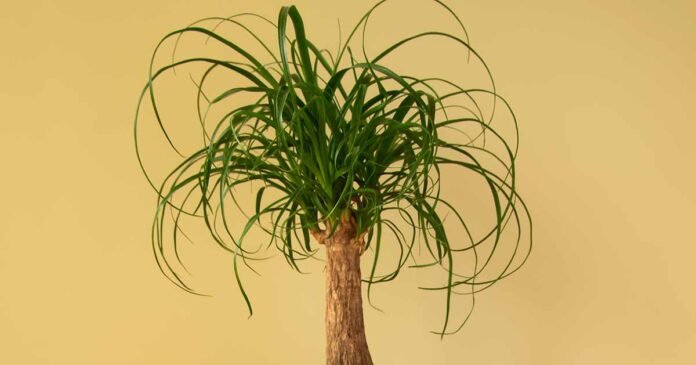Water
Keep in mind that this plant is like a cactus, and it’s better to err on the side of neglect than to overwater.
The caudex is a water-storing marvel that enables this palm to endure semi-desert conditions, tolerating drought, and going a few weeks without supplemental moisture.
When watering, be sure that the soil has dried out completely since the last time you got out your watering can.
For a houseplant that’s small enough to lift, take it to the sink, and water until it runs out of the drainage hole(s), to thoroughly saturate the roots.
Water a second time, and when the dripping stops, return the potted palm to its regular location.
This second watering ensures that there are no dry air pockets.
Fertilizing
Apply a liquid cactus and succulent liquid plant food at planting time, and each spring.
Some folks feed their plants every two weeks or so throughout the growing season, but this is counterproductive if you’re trying to keep your plant small.
Where to Buy
Potted ponytail palms are readily available for home cultivation.
Upon receipt, gently remove the plant from the nursery starter pot, and transplant it to a porous, well-draining container filled three-quarters full of cactus and succulent potting mix.
The pot should fit snugly, and be about two inches wider than the width of the basal caudex.
You can find ponytail palms in one-, three-, and seven-gallon pots available from Fast Growing Trees.
Maintenance
Ponytail palm does not require pruning, but sometimes the tips or the entire leaves may turn brown.
If you find this to be aesthetically displeasing, you can cut off the offending foliage as near to its point of origin as possible, to avoid leaving partially cut stems with a “chopped” look.


If you find yourself pruning brown foliage, consider the source of the desiccation. Are the leaves being scorched by direct sunlight? Are you underwatering?
Underwatered foliage may turn yellow and then brown, as it dries out. The trunk may begin to shrink with the moisture deficit.
Excess moisture can cause the leaves to droop and turn yellow. If it persists, the trunk may soften.
In addition to pruning that removes dry foliage, you may want to try your hand at bonsai.
A ponytail palm is a great candidate for the ancient Asian art of miniaturizing trees with selective pruning to stunt growth while preserving natural forms.
Repotting
Let your palm remain in a snug-fitting pot until its roots are so dense that they become root bound and peek out from the bottom of the pot.
With this slow-growing species, it may be years before crowded roots are an issue. On the other hand, it’s possible to purchase a nursery plant that is bursting at the seams and needs to be put in a larger pot right away.
The best time to repot is in early spring, before the growing season gets underway.
Conversely, instead of stunting growth by limiting root space, some folks prefer to encourage maximum growth by putting their plant in a very large pot that exceeds the snug two-inches-to-spare fit.



